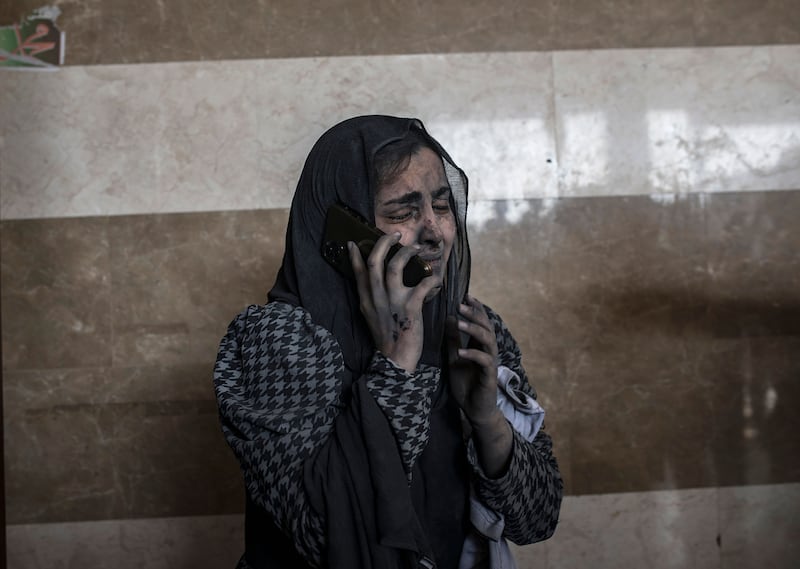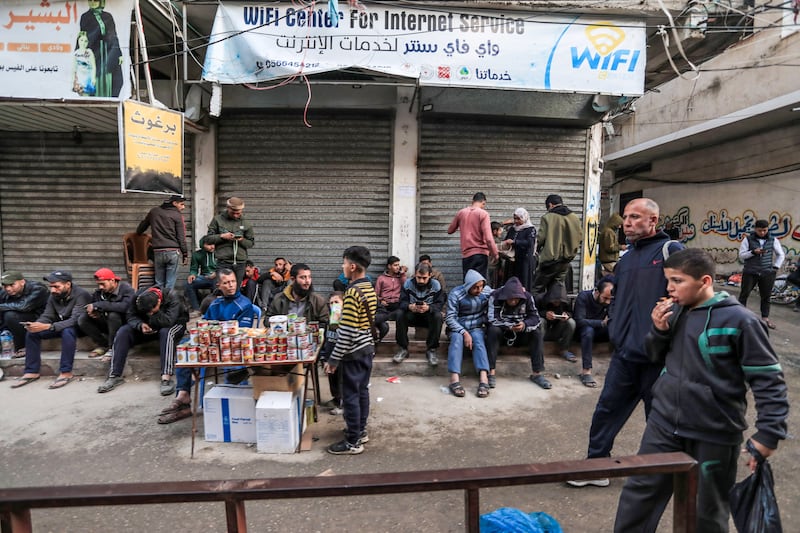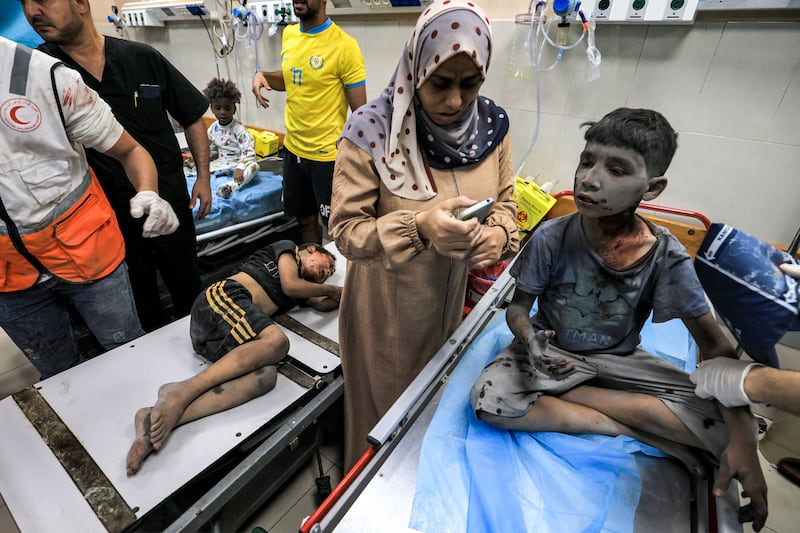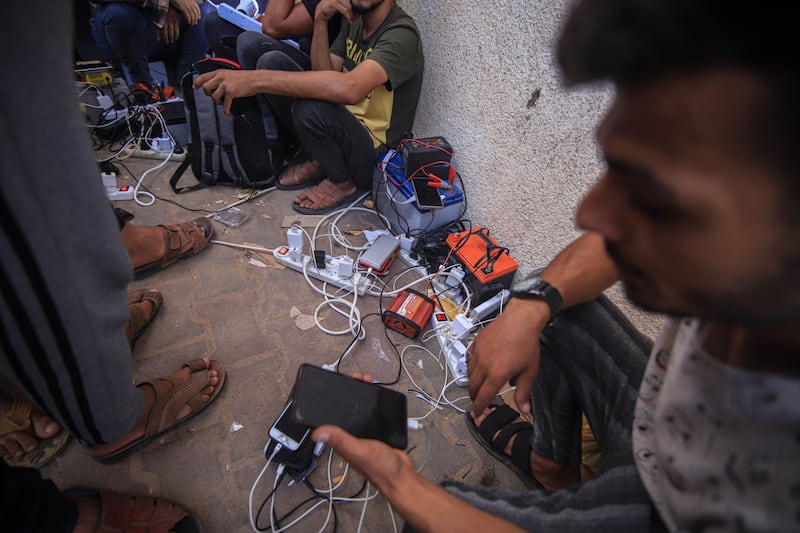When Mohammed Sweirky prepared to leave for a work trip in January to repair telecommunications infrastructure that had been destroyed in the northern Gaza Strip, his wife and children pleaded with him not to go.
Fighting between Israeli troops and Hamas members was still raging in the area, said Sweirky, who is a technician for Paltel, the largest telecommunications company in Gaza, and his family worried he might not return. But he said he felt he had no choice given that residents there desperately needed their phone services restored.
“It was painful to say bye,” said Sweirky (50), who fled Gaza City at the beginning of the war and is now sheltering with six family members in a garage in Rafah, the territory’s southernmost city. “They were crying, but I couldn’t abandon our mission.”
Sweirky’s job has become among the most dangerous in Gaza and one of the most important since the start of the war. Israel’s bombing campaign against Hamas has pummelled telecommunications infrastructure, destroying subterranean fibre cables, damaging data centres and blowing up cell towers.
Hundreds of thousands flee as Israel seizes Rafah in new Gaza ‘security zone’
Hungary says it is withdrawing from International Criminal Court as Netanyahu visits
‘I’m here! Can you hear me?’ One family’s story of death in Gaza
‘We are begging for help to bring them here’: Mothers of sick Palestinian children plead with Government for loved ones to join
Since the war began, 50 engineers and technicians at Paltel, one of two Palestinian cell service providers in Gaza, have criss-crossed the enclave to reinstate service in neighbourhoods that have been plunged into blackouts for days and even weeks.

Paltel – which is dependent on three telecommunication lines that pass through Israel – operates infrastructure in Gaza. Trying to repair that infrastructure has entailed enormous risks for Paltel technicians, who often have to work near battles and say they have also come under fire.
At least two Paltel employees have been killed on the job, according to the company and the Palestinian Authority’s telecommunications ministry. A total of 16 have died since the war began, Paltel said.
Blackouts across Gaza have severely hampered the ability of Palestinians to call for help, report on unfolding events, co-ordinate the delivery of aid, and communicate with friends and family abroad. Calls routinely go straight to voicemail, and when they connect, the connection is often weak.
Some Palestinians in Gaza have found ways to bypass the blackouts by using cards compatible with Israeli or Egyptian networks and by connecting to backup infrastructure known as microwave link.
“During a war, the difference between life and death can be one phone call,” said Tariq Bakhit (33), an emergency medical worker. “We can barely do anything without the ability to communicate.”

A Paltel executive and the Palestinian Authority’s telecommunications ministry blame most of the poor connectivity on air strikes and on bulldozed roads, causing damage to infrastructure above and below ground.
But the executive, Mamoon Fares, head of Paltel’s Gaza emergency committee, said Israel had also shut down communications in Gaza three times. He said Paltel had come to that conclusion because the network was later restored without its intervention on those occasions. The Israeli military declined to comment.
Fares said dozens of miles of Paltel’s fibre cables had been destroyed, two of its four major data centres put offline and more than 100 of its cell towers wrecked in the fighting.
Before Paltel employees enter Israeli-controlled areas, the company says it sends the names, ID numbers and licence plate information of technicians to international organisations or Palestinian officials, who transfer the data to Israeli security officials. After receiving Israel’s permission to embark on a project, employees adhere to instructions from Israeli officials, including specific routes they outline on maps, the company said.
But there have still been several close calls and one deadly incident, according to Paltel.

In mid-December, members of a Paltel team found themselves in the middle of the fighting. They were trying to reconnect a cable underwater in a crater in the southern city of Khan Younis when clashes between the Israeli military and militants erupted, said Kamel Amsy (52), an engineer on the team. Overcome with fear, they lay flat on the ground as bullets flew overhead.
“The tanks nearby went crazy,” he said. “The situation was petrifying.”
When Fares called Palestinian officials to request they inform their Israeli counterparts that his employees were in the line of fire, according to established protocol, the Israelis said the technicians should stay put, he recalled.
Half an hour later, a soldier emerged from a tank and told the technicians to evacuate eastward, but there was no way for their cars to pass through the crater, Amsy said. Worried for their lives, they drove westward until they escaped the fighting, he said.
The next day, the technicians completed the job, which was aimed at bringing connectivity back to southern Gaza after a multiday blackout.

Asked later about the event, the Israeli army said it had given Paltel technicians permission to work in the area, but later told them not to come because of “operational activity” there. It said the army was not aware of tank fire directed at the technicians, whom it said were not a target.
In another incident in December, Nader Abu Hajjaj (49), a technician from Khan Younis, was fixing cables and replacing batteries on a building in his hometown, when he said it was hit by air strikes. “It was a disaster,” Abu Hajjaj said during an interview in January. “We co-ordinated our movements, but they still fired at us.”
The Israeli military said it was targeting an anti-tank launching position on the roof of the building and fire was halted once it was informed that Paltel employees were present.
Two weeks later, Abu Hajjaj was less fortunate. While returning from a project in Khan Younis, his car was struck by tank fire, killing him and Bahaa al-Rayes, his colleague, according to Paltel. Fares said an employee who was injured in the episode reported that it was caused by a tank opening fire.
The Israeli army said it was investigating the incident. Cogat, the Israeli agency responsible for liaising with Palestinians, confirmed that Paltel had co-ordinated the movements of Abu Hajjaj and Rayes with it.

While Paltel still does not know the exact extent of the damage to its assets in Gaza, Fares said 80 per cent of its network was offline, including a considerable portion that needed to be replaced. He predicted that it would take years to fix the full network and the repair would depend on the pace of the broader reconstruction process.
A major challenge to rebuilding the network, Fares said, was Israel’s blocking of equipment including antennas, fibre cables and microwave dishes into Gaza.
Eyhab Esbaih, a senior official in the telecommunications ministry, said discussions were continuing with Israel through international interlocutors about bringing in equipment. Like Fares, he said Israel had not yet allowed such items in.
Cogat said it was permitting the entry of spare parts for communications infrastructure, but declined to specify what had been allowed in. Israeli officials have long been reluctant to allow what they consider dual-use items into Gaza – equipment that can be used for both military and civilian purposes.
Technicians say they have also been frustrated by run-ins with Israeli forces. In December, Amsy and Sweirky said they and several technicians were held at gunpoint during a trip to northern Gaza to fix damaged cables.
Amsy said soldiers had blindfolded him and zip-tied his wrists before accusing him and other technicians of taking footage of the area. He said they were released only after he convinced them that they were on a repair mission approved by the military.
“It was incredibly demeaning,” Amsy said. “You’re trying to do your job, but you receive no respect.”
Asked about the episode, the Israeli army did not specifically comment on Amsy’s description of the soldiers’ actions or confirm the incident. Instead, it said that all detainees should “be treated with respect and dignity”.
After being freed, most of the technicians wanted to call off the project, but Amsy said they needed to do everything possible to improve communications in the north and kept going.
But as they came close to their destination, a tank began firing nearby, they said. “At that point, we realised we were on an impossible mission,” Amsy said. “We were left with no choice but to head home.” Fares said he was on the phone with the technicians when the episode occurred and heard firing.
The Israeli military said the incident could not be identified using the details provided. – This article originally appeared in The New York Times.
2024 The New York Times Company












